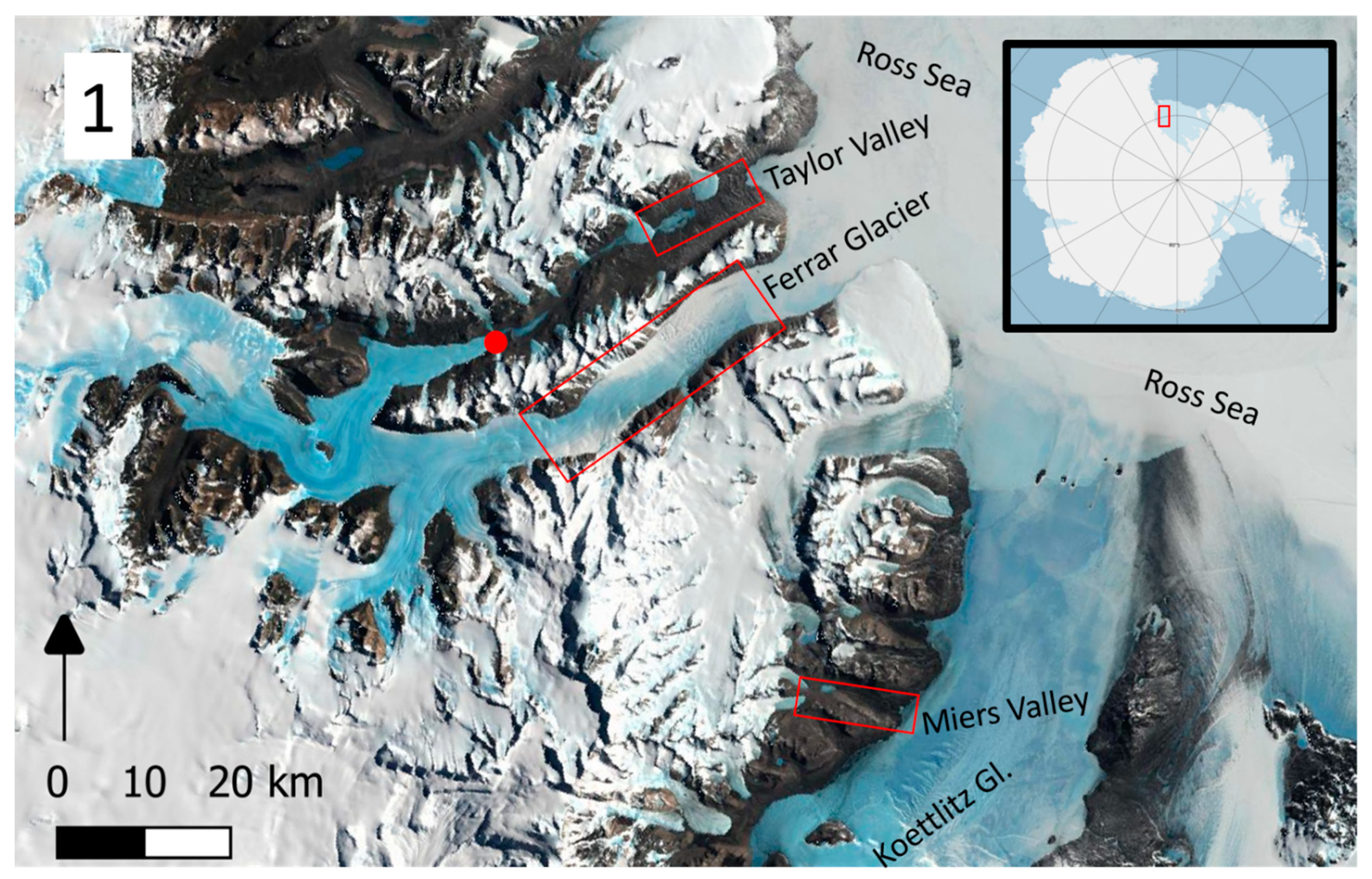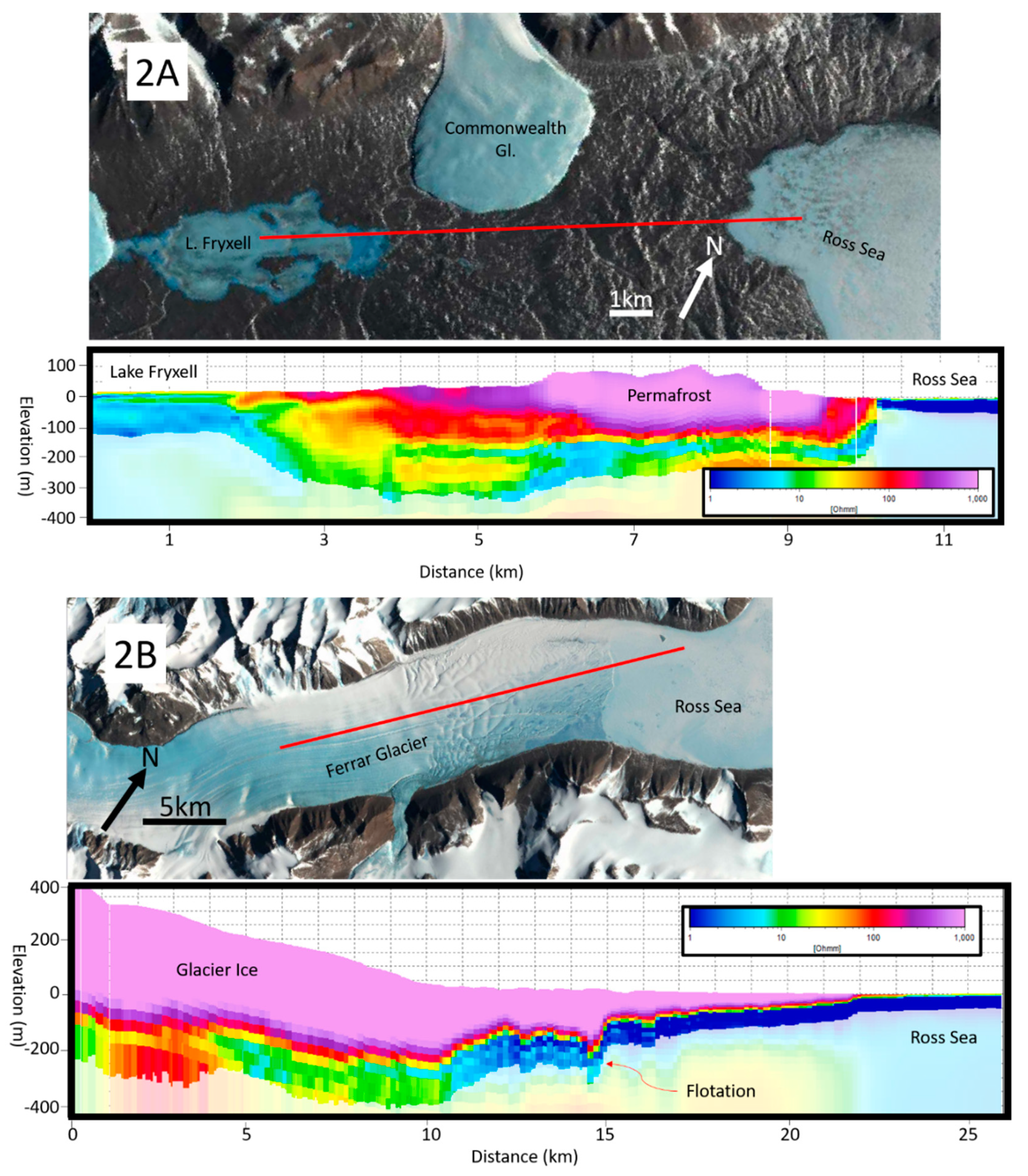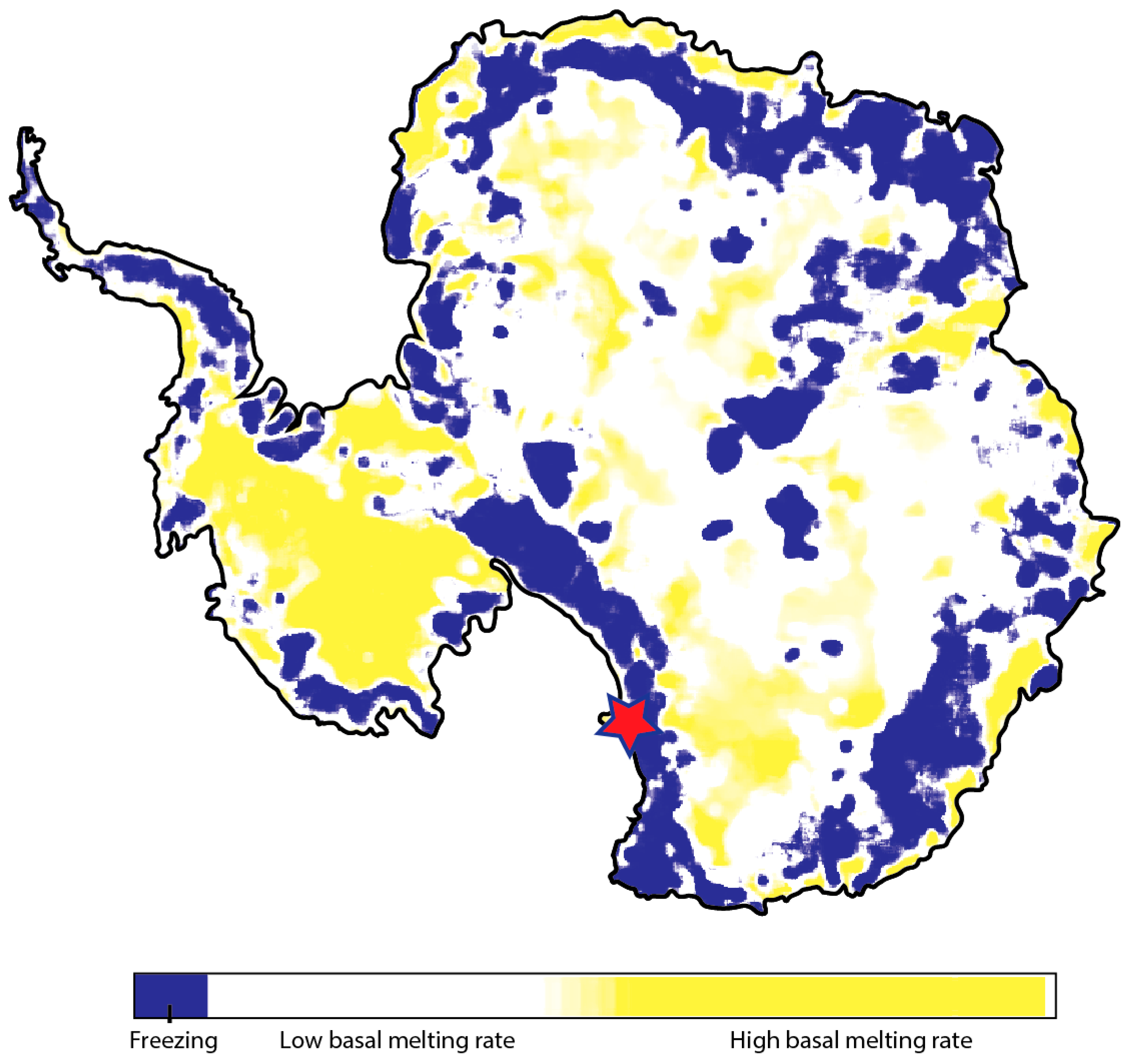Evidence for Pathways of Concentrated Submarine Groundwater Discharge in East Antarctica from Helicopter-Borne Electrical Resistivity Measurements
Abstract
1. Introduction
- (1)
- Terrestrial hydraulic gradients, which drive Darcian flow;
- (2)
- Oceanic processes, which include wave and tidal pumping, among many others;
- (3)
- Endogenic drivers, which include buoyant instabilities and osmotic pressure.
2. Setting and Methods
3. Results and Discussion
- (1)
- Lower Taylor Valley, where Lake Fryxell is connected to a deeper aquifer through a talik (unfrozen region) beneath the lake. This aquifer connects to the Ross Sea. This system is overlaid by permafrost between Lake Fryxell and the Ross Sea. (Figure 2A)
- (2)
- Ferrar Glacier, where subglacial brines have an open connection directly into the Ross Sea. (Figure 2B)
- (3)
- Miers Valley, where subpermafrost brines occur roughly at sea level but under a thin (and likely growing) layer of permafrost. (Figure 2C)
3.1. Surface Slope Driven Darcian Flow
3.2. Volume Expansion Driven Darcian Flow Due to Permafrost Growth
3.3. Darcian Flow as a Transmitter of Nutrients on a Continental Scale
4. Conclusions
Author Contributions
Funding
Acknowledgments
Conflicts of Interest
References
- Burnett, W.C.; Bokuniewicz, H.; Huettel, M.; Moore, W.S.; Taniguchi, M. Groundwater and Pore Water Inputs to the Coastal Zone. Biogeochemistry 2003, 66, 3–33. [Google Scholar] [CrossRef]
- Moore, W.S. The Effect of Submarine Groundwater Discharge on the Ocean. Ann. Rev. Mar. Sci. 2009, 2, 59–88. [Google Scholar] [CrossRef] [PubMed]
- Simmons, G.M. Importance of submarine groundwater discharge (SGWD) and seawater cycling to material flux across sediment/water interfaces in marine environments. Mar. Ecol. Prog. Ser. 1992, 84, 173–184. [Google Scholar] [CrossRef]
- Santos, I.R.; Eyre, B.D.; Huettel, M. The driving forces of porewater and groundwater flow in permeable coastal sediments: A review. Estuar. Coast. Shelf Sci. 2012, 98, 1–15. [Google Scholar] [CrossRef]
- Kwon, E.Y.; Kim, G.; Primeau, F.; Moore, W.S.; Cho, H.-M.; DeVries, T.; Sarmiento, J.L.; Charette, M.A.; Cho, Y.-K. Global estimate of submarine groundwater discharge based on an observationally constrained radium isotope model. Geophys. Res. Lett. 2014, 41, 8438–8444. [Google Scholar] [CrossRef]
- Lecher, A. Groundwater Discharge in the Arctic: A Review of Studies and Implications for Biogeochemistry. Hydrology 2017, 4, 41. [Google Scholar] [CrossRef]
- Lecher, A.L.; Chien, C.-T.; Paytan, A. Submarine groundwater discharge as a source of nutrients to the North Pacific and Arctic coastal ocean. Mar. Chem. 2016, 186, 167–177. [Google Scholar] [CrossRef]
- Frederick, J.M.; Buffett, B.A. Effects of submarine groundwater discharge on the present-day extent of relict submarine permafrost and gas hydrate stability on the Beaufort Sea continental shelf. J. Geophys. Res. Earth Surf. 2015, 120, 417–432. [Google Scholar] [CrossRef]
- DeFoor, W.; Person, M.; Larsen, H.C.; Lizarralde, D.; Cohen, D.; Dugan, B. Ice sheet-derived submarine groundwater discharge on Greenland’s continental shelf. Water Resour. Res. 2011, 47. [Google Scholar] [CrossRef]
- Uemura, T.; Taniguchi, M.; Shibuya, K. Submarine groundwater discharge in Lützow-Holm Bay, Antarctica. Geophys. Res. Lett. 2011, 38. [Google Scholar] [CrossRef]
- Lecher, A.L.; Kessler, J.; Sparrow, K.; Garcia-Tigreros Kodovska, F.; Dimova, N.; Murray, J.; Tulaczyk, S.; Paytan, A. Methane transport through submarine groundwater discharge to the North Pacific and Arctic Ocean at two Alaskan sites. Limnol. Oceanogr. 2016, 61, S344–S355. [Google Scholar] [CrossRef]
- Mahowald, N.M.; Baker, A.R.; Bergametti, G.; Brooks, N.; Duce, R.A.; Jickells, T.D.; Kubilay, N.; Prospero, J.M.; Tegen, I. Atmospheric global dust cycle and iron inputs to the ocean. Glob. Biogeochem. Cycles 2005, 19. [Google Scholar] [CrossRef]
- Slomp, C.P.; Van Cappellen, P. Nutrient inputs to the coastal ocean through submarine groundwater discharge: controls and potential impact. J. Hydrol. 2004, 295, 64–86. [Google Scholar] [CrossRef]
- Tréguer, P.; Jacques, G. Dynamics of nutrient and phytoplankton and cycles of carbon, nitrogen and silicon in the Southern Ocean: a review. Polar Biol. 1992, 12, 149–162. [Google Scholar] [CrossRef]
- Moore, J.K.; Abbott, M.R. Phytoplankton Chlorophyll Distributions and Primary Production in the Southern Ocean. J. Geophys. Res. 2000, 105, 28709–28722. [Google Scholar] [CrossRef]
- De Baar, H.J.W.; Buma, A.G.J.; Nolting, R.F.; Cadée, G.C.; Jacques, G.; Tréguer, P.J. On iron limitation of the Southern Ocean: experimental observations in the Weddell and Scotia Seas. Mar. Ecol. Prog. Ser. 1990, 65, 105–122. [Google Scholar] [CrossRef]
- Martin, J.H.; Gordon, R.M.; Steve, E.F.; Fitzwater, S.E. Iron in Antarctic waters. Nature 1990, 345, 156–158. [Google Scholar] [CrossRef]
- Gerringa, L.J.A.A.; Alderkamp, A.-C.; Laan, P.; Thuróczy, C.-E.; De Baar, H.J.W.W.; Mills, M.M.; van Dijken, G.L.; van Haren, H.; Arrigo, K.R. Iron from melting glaciers fuels the phytoplankton blooms in Amundsen Sea (Southern Ocean): Iron biogeochemistry. Deep Sea Res. Part II Top. Stud. Oceanogr. 2012, 71–76, 16–31. [Google Scholar] [CrossRef]
- Thuróczy, C.-E.; Alderkamp, A.-C.; Laan, P.; Gerringa, L.J.A.; Mills, M.M.; Van Dijken, G.L.; De Baar, H.J.W.; Arrigo, K.R. Key role of organic complexation of iron in sustaining phytoplankton blooms in the Pine Island and Amundsen Polynyas (Southern Ocean). Deep Sea Res. Part II Top. Stud. Oceanogr. 2012, 71–76, 49–60. [Google Scholar] [CrossRef]
- Raiswell, R.; Benning, L.G.; Tranter, M.; Tulaczyk, S. Bioavailable iron in the Southern Ocean: The significance of the iceberg conveyor belt. Geochem. Trans. 2008, 9, 7. [Google Scholar] [CrossRef]
- Wadham, J.L.; De’ath, R.; Monteiro, F.M.; Tranter, M.; Ridgwell, A.; Raiswell, R.; Tulaczyk, S. The potential role of the Antarctic Ice Sheet in global biogeochemical cycles. Earth Environ. Sci. Trans. R. Soc. Edinburgh 2013, 104, 55–67. [Google Scholar] [CrossRef]
- Wadham, J.L.; Tranter, M.; Skidmore, M.; Hodson, A.J.; Priscu, J.; Lyons, W.B.; Sharp, M.; Wynn, P.; Jackson, M. Biogeochemical weathering under ice: Size matters. Global Biogeochem. Cycles 2010, 24, 3025. [Google Scholar] [CrossRef]
- McKay, C.P.; Hand, K.P.; Doran, P.T.; Andersen, D.T.; Priscu, J.C. Clathrate formation and the fate of noble and biologically useful gases in Lake Vostok, Antarctica. Geophys. Res. Lett. 2003, 30. [Google Scholar] [CrossRef]
- Michaud, A.B.; Dore, J.E.; Achberger, A.M.; Christner, B.C.; Mitchell, A.C.; Skidmore, M.L.; Vick-Majors, T.J.; Priscu, J.C. Microbial oxidation as a methane sink beneath the West Antarctic Ice Sheet. Nat. Geosci. 2017, 10, 582–586. [Google Scholar] [CrossRef]
- Mikucki, J.A.; Pearson, A.; Johnston, D.T.; Turchyn, A.V.; Farquhar, J.; Schrag, D.P.; Anbar, A.D.; Priscu, J.C.; Lee, P.A. A Contemporary Microbially Maintained Subglacial Ferrous “Ocean”. Science 2009, 324, 397–400. [Google Scholar] [CrossRef]
- Lyons, W.B.; Mikucki, J.A.; German, L.A.; Welch, K.A.; Welch, S.A.; Gardner, C.B.; Tulaczyk, S.M.; Pettit, E.C.; Kowalski, J.; Dachwald, B. The Geochemistry of Englacial Brine from Taylor Glacier, Antarctica. J. Geophys. Res. Biogeosci. 2019, 124, 633–648. [Google Scholar] [CrossRef]
- Mikucki, J.A.J.; Foreman, C.C.M.; Sattler, B.; Berry Lyons, W.; Priscu, J.C. Geomicrobiology of Blood Falls: An Iron-Rich Saline Discharge at the Terminus of the Taylor Glacier, Antarctica. Aquat. Geochem. 2004, 10, 199–220. [Google Scholar] [CrossRef]
- Mikucki, J.A.; Auken, E.; Tulaczyk, S.; Virginia, R.A.; Schamper, C.; Sørensen, K.I.; Doran, P.T.; Dugan, H.; Foley, N. Deep groundwater and potential subsurface habitats beneath an Antarctic dry valley. Nat. Commun. 2015, 6, 6831. [Google Scholar] [CrossRef]
- Tréguer, P.J. The Southern Ocean silica cycle. Comptes Rendus - Geosci. 2014, 346, 279–286. [Google Scholar] [CrossRef]
- Green, W.J.; Stage, B.R.; Preston, A.; Wagers, S.; Shacat, J.; Newell, S. Geochemical processes in the Onyx River, Wright Valley, Antarctica: Major ions, nutrients, trace metals. Geochim. Cosmochim. Acta 2005, 69, 839–850. [Google Scholar] [CrossRef]
- Tulaczyk, S.; Mikucki, J.A.; Siegfried, M.R.; Priscu, J.C.; Barcheck, C.G.; Beem, L.H.; Behar, A.; Burnett, J.; Christner, B.C.; Fisher, A.T.; et al. WISSARD at Subglacial Lake Whillans, West Antarctica: scientific operations and initial observations. Ann. Glaciol. 2014, 55, 51–58. [Google Scholar] [CrossRef]
- Joughin, I.R.; Tulaczyk, S.; Engelhardt, H.F. Basal melt beneath Whillans Ice Stream and Ice Streams A and C, West Antarctica. Ann. Glaciol. 2003, 36, 257–262. [Google Scholar] [CrossRef][Green Version]
- Pattyn, F. Antarctic subglacial conditions inferred from a hybrid ice sheet/ice stream model. Earth Planet. Sci. Lett. 2010, 295, 451–461. [Google Scholar] [CrossRef]
- Levy, J. How big are the McMurdo Dry Valleys? Estimating ice-free area using Landsat image data. Antarct. Sci. 2013, 25, 119–120. [Google Scholar] [CrossRef]
- Doran, P.T.; McKay, C.P.; Clow, G.D.; Dana, G.L.; Fountain, A.G.; Nylen, T.; Lyons, W.B. Valley floor climate observations from the McMurdo dry valleys, Antarctica, 1986-2000. J. Geophys. Res. Atmos. 2002, 107. [Google Scholar] [CrossRef]
- Levy, J.S.; Fountain, A.G.; Gooseff, M.N.; Welch, K.A.; Lyons, W.B. Water tracks and permafrost in Taylor Valley, Antarctica: Extensive and shallow groundwater connectivity in a cold desert ecosystem. Geol. Soc. Am. Bull. 2011, 123, 2295–2311. [Google Scholar] [CrossRef]
- Sugden, D.; Denton, G.; Marchant, D. Landscape evolution of the Dry Valleys, Transantarctic Mountains: Tectonic implications. J. Geophys. Res. 1995, 100, 9949–9967. [Google Scholar] [CrossRef]
- Keys, J. Saline discharge at the terminus of the Taylor Glacier. Antarct. J. US 1979, 14, 82–85. [Google Scholar]
- Foley, N.; Tulaczyk, S.; Auken, E.; Schamper, C.; Dugan, H.; Mikucki, J.; Virginia, R.; Doran, P. Helicopter-borne transient electromagnetics in high-latitude environments: An application in the McMurdo Dry Valleys, Antarctica. Geophysics 2015, 81, WA87–WA99. [Google Scholar] [CrossRef]
- Lyons, B.W.; Frape, S.K.; Welch, K.A. History of McMurdo Dry Valley lakes, Antarctica, from stable chlorine isotope data. Geology 1999, 27, 527. [Google Scholar] [CrossRef]
- Campen, R.; Kowalski, J.; Lyons, W.B.; Tulaczyk, S.; Dachwald, B.; Pettit, E.; Welch, K.A.; Mikucki, J.A. Microbial diversity of an Antarctic subglacial community and high-resolution replicate sampling inform hydrological connectivity in a polar desert. Environ. Microbiol. 2019. [Google Scholar] [CrossRef]
- Badgeley, J.A.; Pettit, E.C.; Carr, C.G.; Tulaczyk, S.; Mikucki, J.A.; Lyons, W.B. An englacial hydrologic system of brine within a cold glacier: Blood Falls, McMurdo Dry Valleys, Antarctica. J. Glaciol. 2017, 63, 387–400. [Google Scholar] [CrossRef]
- Bindschadler, R.; Vornberger, P.; Fleming, A.; Fox, A.; Mullins, J.; Binnie, D.; Paulsen, S.J.; Granneman, B.; Gorodetzky, D. The Landsat Image Mosaic of Antarctica. Remote Sens. Environ. 2008, 112, 4214–4226. [Google Scholar] [CrossRef]
- Dugan, H.A.; Doran, P.T.; Tulaczyk, S.; Mikucki, J.A.; Arcone, S.A.; Auken, E.; Schamper, C.; Virginia, R.A. Subsurface imaging reveals a confined aquifer beneath an ice-sealed Antarctic lake. Geophys. Res. Lett. 2015, 42, 96–103. [Google Scholar] [CrossRef]
- Sørensen, K.I.; Auken, E. SkyTEM—A new high-resolution transient electromagnetic system. Explor. Geophys. 2004, 35, 191–199. [Google Scholar] [CrossRef]
- Auken, E.; Christiansen, A.V. Layered and laterally constrained 2D inversion of resistivity data. Geophysics 2004, 69, 752. [Google Scholar] [CrossRef]
- Christiansen, A.V.; Auken, E. A global measure for depth of investigation. Geophysics 2012, 77, WB171. [Google Scholar] [CrossRef]
- McGinnis, L.D.; Stuckless, J.S.; Osby, D.R.; Kyle, P.R. Gamma Ray, Salinity, and Electric Logs of DVDP Boreholes. Dry Val. Drill. Proj. 1981, 33, 95–108. [Google Scholar]
- McGinnis, L.D.; Nakao, K.; Clark, C.C. Geophysical Identification of Frozen and Unfrozen Ground Antarctica. In Permafrost: North American contribution [to the] Second International Conference; National Academy of Sciences: Washington, DC, USA, 1973; pp. 136–146. [Google Scholar]
- McGinnis, L.D.; Osby, D.R.; Kohout, R. Paleohydrology inferred from salinity measurements on Dry Valley Drilling Project cores from Taylor Valley, Antarctica. Antarct. Geosci. 1982, 4, 1133–1138. [Google Scholar]
- McGinnis, L.D.; Jensen, T.E. Permafrost-Hydrogeologic Regimen in Two Ice-Free Valleys, Antarctica, from Electrical Depth Sounding. Quat. Res. 1971, 409, 389–409. [Google Scholar] [CrossRef]
- Prieto, C.; Destouni, G. Quantifying hydrological and tidal influences on groundwater discharges into coastal waters. Water Resour. Res. 2005, 41. [Google Scholar] [CrossRef]
- Li, L.; Barry, D.A.; Stagnitti, F.; Parlange, J.-Y. Submarine groundwater discharge and associated chemical input to a coastal sea. Water Resour. Res. 1999, 35, 3253–3259. [Google Scholar] [CrossRef]
- Skidmore, M.; Tranter, M.; Tulaczyk, S.; Lanoil, B. Hydrochemistry of ice stream beds-Evaporitic or microbial effects? Hydrol. Process. 2010, 24, 517–523. [Google Scholar]
- Freeze, R.A.; Cherry, J.A. Groundwater; Prentice-Hall: New York, NY, USA, 1979; ISBN 0-13-365312-9. [Google Scholar]
- Hazen, A. Some physical properties of sands and gravels. Mass. State Board of Health. 24th Annu. Rep. 1892, 539–556. [Google Scholar]
- Salarashayeri, A.F.; Siosemarde, M. Prediction of soil hydraulic conductivity from particle-size distribution. World Acad. Sci. Eng. Technol. 2012, 61, 454–458. [Google Scholar]
- Powell, R. Sedimentation Conditions in Taylor Valley, Antarctica, Inferred from Textural Analysis of DVDP Cores. In Dry Valley Drilling Project; American Geophysical Union: San Francisco, CA, USA, 2013; Volume 33, pp. 331–349. ISBN 9781118664643. [Google Scholar]
- Domenico, P.A.; Schwartz, F.W. Physical and Chemical Hydrogeology; John Wiley and Sons: New York, NY, USA, 1990. [Google Scholar]
- McGinnis, L.D. Artesian well at Don Juan Pond. Antarct. J. US 1979, 14, 26–27. [Google Scholar]
- Falconer, T.; Pyne, A.; Wilson, D.; Levy, R.; Nielsen, S.; Petrushak, S. Operations overview for the ANDRILL Southern McMurdo Sound Project, Antarctica. Terra Antart. 2008, 15, 41–48. [Google Scholar]
- Hendy, C.H. Late Quaternary Lakes in the McMurdo Sound Region of Antarctica. Geogr. Ann. Ser. A Phys. Geogr. 2004, 82, 411–432. [Google Scholar] [CrossRef]
- Hall, B.B.L.; Denton, G.G.H.; Hendy, C.H. Evidence from Taylor Valley for a grounded ice sheet in the Ross Sea, Antarctica. Geogr. Ann. Ser. A Phys. Geogr. 2000, 82, 275–303. [Google Scholar] [CrossRef]
- Lyons, W.B.B.; Tyler, S.W.W.; Wharton, R.A.A.; McKnight, D.M.M.; Vaughn, B.H.H. A Late Holocene desiccation of Lake Hoare and Lake Fryxell, McMurdo Dry Valleys, Antarctica. Antarct. Sci. 1998, 10, 247–256. [Google Scholar] [CrossRef]
- Cuffey, K.M.; Paterson, W.S.B. The Physics of Glaciers; Academic Press: New York, NY, USA, 2010; ISBN 008091912X. [Google Scholar]
- Hall, B.L.; Baroni, C.; Denton, G.H. Holocene relative sea-level history of the Southern Victoria Land Coast, Antarctica. Glob. Planet. Change 2004, 42, 241–263. [Google Scholar] [CrossRef]
- Osterkamp, T.E.; Burn, C.R. Permafrost. Encycl. Atmos. Sci. 2003, 1717–1729. [Google Scholar]
- Null, K.A.; Reide Corbett, D.; Crenshaw, J.; Peterson, R.N.; Peterson, L.E.; Lyons, W.B. Groundwater discharge to the western Antarctic coastal ocean. Polar Res. 2019, 38. [Google Scholar] [CrossRef]
- Döll, P.; Fiedler, K. Global-scale modeling of groundwater recharge. Hydrol. Earth Syst. Sci. 2008, 12, 863–885. [Google Scholar] [CrossRef]
- Priscu, J.C.; Tulaczyk, S.; Studinger, M.; Kennicutt II, M.C.; Christner, B.C.; Foreman, C.M. Antarctic subglacial water: Origin, evolution, and ecology. In Polar Lakes and Rivers; Oxford University Press: Oxford, England, 2008; ISBN 9780199213887. [Google Scholar]
- Christner, B.C.; Priscu, J.C.; Achberger, A.M.; Barbante, C.; Carter, S.P.; Christianson, K.; Michaud, A.B.; Mikucki, J.A.; Mitchell, A.C.; Skidmore, M.L.; et al. A microbial ecosystem beneath the West Antarctic ice sheet. Nature 2014, 512, 310–313. [Google Scholar] [CrossRef] [PubMed]
- Gosselin, D.C.; Harvey, F.E.; Frost, C.D. Geochemical evolution of ground water in the Great Plains (Dakota) Aquifer of Nebraska: Implications for the management of a regional aquifer system. Groundwater 2001, 39, 98–108. [Google Scholar] [CrossRef]
- Kim, M.-J.; Nriagu, J.; Haack, S. Arsenic species and chemistry in groundwater of southeast Michigan. Environ. Pollut. 2002, 120, 379–390. [Google Scholar] [CrossRef]
- Cartwright, K.; Harris, H. Hydrogeology of the Dry Valley Region, Antarctica. Antarct. Res. Ser. 1981, 33. [Google Scholar] [CrossRef]




| Ion | Concentration (µM) | Flux of Ions (Gg/year) | |
|---|---|---|---|
| At 1 km3/year SGD | At 65 km3/year SGD | ||
| Fe(II) (Blood Falls outflow, filtered to remove insoluble particulates) a | 3000 | 170 | 11,000 a |
| Fe (total iron, direct englacial sample, unfiltered) b | 476 | 30 | 1700 |
| Fe(II) (direct englacial sample, filtered to remove insoluble particulates) b | 351 | 20 | 1300 |
| Si a | 600 | 17 | 1100 a |
| Si b | 484 | 14 | 900 |
© 2019 by the authors. Licensee MDPI, Basel, Switzerland. This article is an open access article distributed under the terms and conditions of the Creative Commons Attribution (CC BY) license (http://creativecommons.org/licenses/by/4.0/).
Share and Cite
Foley, N.; Tulaczyk, S.M.; Grombacher, D.; Doran, P.T.; Mikucki, J.; Myers, K.F.; Foged, N.; Dugan, H.; Auken, E.; Virginia, R. Evidence for Pathways of Concentrated Submarine Groundwater Discharge in East Antarctica from Helicopter-Borne Electrical Resistivity Measurements. Hydrology 2019, 6, 54. https://doi.org/10.3390/hydrology6020054
Foley N, Tulaczyk SM, Grombacher D, Doran PT, Mikucki J, Myers KF, Foged N, Dugan H, Auken E, Virginia R. Evidence for Pathways of Concentrated Submarine Groundwater Discharge in East Antarctica from Helicopter-Borne Electrical Resistivity Measurements. Hydrology. 2019; 6(2):54. https://doi.org/10.3390/hydrology6020054
Chicago/Turabian StyleFoley, Neil, Slawek M. Tulaczyk, Denys Grombacher, Peter T. Doran, Jill Mikucki, Krista F. Myers, Nikolaj Foged, Hilary Dugan, Esben Auken, and Ross Virginia. 2019. "Evidence for Pathways of Concentrated Submarine Groundwater Discharge in East Antarctica from Helicopter-Borne Electrical Resistivity Measurements" Hydrology 6, no. 2: 54. https://doi.org/10.3390/hydrology6020054
APA StyleFoley, N., Tulaczyk, S. M., Grombacher, D., Doran, P. T., Mikucki, J., Myers, K. F., Foged, N., Dugan, H., Auken, E., & Virginia, R. (2019). Evidence for Pathways of Concentrated Submarine Groundwater Discharge in East Antarctica from Helicopter-Borne Electrical Resistivity Measurements. Hydrology, 6(2), 54. https://doi.org/10.3390/hydrology6020054





